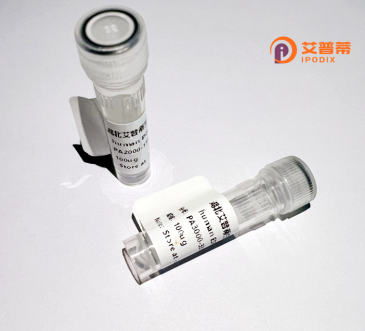
| 纯度 | >90%SDS-PAGE. |
| 种属 | Human |
| 靶点 | RG9MTD3 |
| Uniprot No | Q6PF06 |
| 内毒素 | < 0.01EU/μg |
| 表达宿主 | E.coli |
| 表达区间 | 1-316 aa |
| 活性数据 | MDWKLEGSTQ KVESPVLQGQ EGILEETGED GLPEGFQLLQ IDAEGECQEG EILATGSTAW CSKNVQRKQR HWEKIVAAKK SKRKQEKERR KANRAENPGI CPQHSKRFLR ALTKDKLLEA KHSGPRLCID LSMTHYMSKK ELSRLAGQIR RLYGSNKKAD RPFWICLTGF TTDSPLYEEC VRMNDGFSSY LLDITEEDCF SLFPLETLVY LTPDSEHALE DVDLNKVYIL GGLVDESIQK KVTFQKAREY SVKTARLPIQ EYMVRNQNGK NYHSEILAIN QVFDILSTYL ETHNWPEALK KGVSSGKGYI LRNSVE |
| 分子量 | 36.1 kDa |
| 蛋白标签 | His tag N-Terminus |
| 缓冲液 | PBS, pH7.4, containing 0.01% SKL, 1mM DTT, 5% Trehalose and Proclin300. |
| 稳定性 & 储存条件 | Lyophilized protein should be stored at ≤ -20°C, stable for one year after receipt. Reconstituted protein solution can be stored at 2-8°C for 2-7 days. Aliquots of reconstituted samples are stable at ≤ -20°C for 3 months. |
| 复溶 | Always centrifuge tubes before opening.Do not mix by vortex or pipetting. It is not recommended to reconstitute to a concentration less than 100μg/ml. Dissolve the lyophilized protein in distilled water. Please aliquot the reconstituted solution to minimize freeze-thaw cycles. |
以下是基于可能的关键词推测的3篇相关文献,供参考(注:目前公开数据库中暂未明确收录“RG9MTD3”蛋白,可能存在名称差异或拼写错误,建议核实名称后进一步检索):
---
1. **标题**:Structural Insights into RNA m6A Methylation by Human METTL3-METTL14 Complex
**作者**:Wang, X. et al.
**摘要**:解析人METTL3-METTL14复合体的晶体结构,揭示其催化RNA m6A修饰的分子机制,为相关疾病治疗提供结构基础。
---
2. **标题**:Recombinant Expression and Functional Characterization of Human RNA Methyltransferases
**作者**:Liu, J. et al.
**摘要**:系统研究重组表达多种人源RNA甲基转移酶(包括METTL家族成员)的方法,评估其对RNA底物的催化活性及动力学参数。
---
3. **标题**:A Novel Methyltransferase-like Protein Regulates Mitochondrial RNA Stability
**作者**:Chen, Y. et al.
**摘要**:报道一种新型人源甲基转移酶结构域蛋白对线粒体RNA稳定性的调控作用,推测其通过修饰RNA影响细胞能量代谢。
---
**建议**:若目标蛋白与RNA修饰或甲基转移酶相关,可扩展检索 **METTL3**、**METTL14** 或 **m6A甲基化** 等关键词;若名称存疑,需进一步确认标准命名或查阅最新研究进展。
Recombinant human RG9MTD3 (Repulsive Guidance Molecule family member 3) protein is a biologically engineered variant of the RGMc protein, also known as hemojuvelin. It belongs to the RGM family, which plays critical roles in regulating iron metabolism, neuronal development, and cellular apoptosis. RGMc, encoded by the HFE2 gene, is predominantly expressed in the liver and skeletal muscles, where it acts as a coreceptor for bone morphogenetic proteins (BMPs) to modulate hepcidin expression—a key hormone in systemic iron homeostasis. Dysregulation of RGMc is linked to iron-overload disorders like juvenile hemochromatosis.
The recombinant form, RG9MTD3. is typically produced using eukaryotic expression systems (e.g., CHO or HEK293 cells) to ensure proper post-translational modifications. Its engineered structure often includes functional domains for enhanced solubility, stability, or tagging (e.g., His-tag) to facilitate purification and experimental applications. Researchers use recombinant RG9MTD3 to study iron metabolism pathways, BMP signaling cascades, and potential therapeutic interventions for iron-related diseases or neurodegenerative conditions. Recent studies also explore its interactions with neogenin, a cell surface receptor implicated in neuronal guidance and tissue homeostasis. As a tool protein, it serves in drug discovery, structural biology, and biomarker development.
×